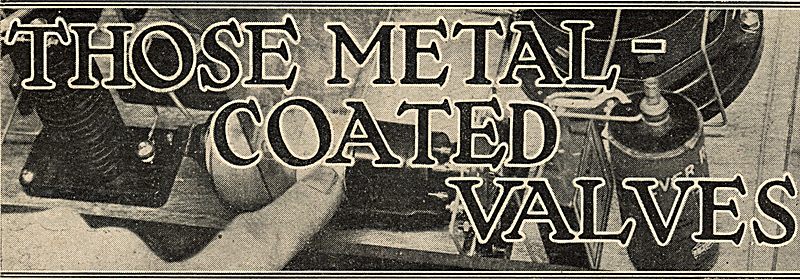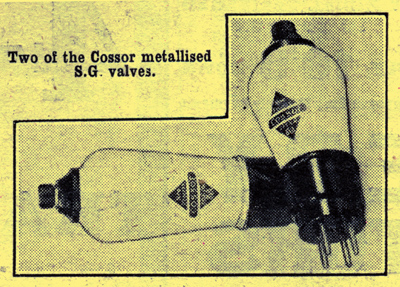|

At the present time, when everyone appears to be saving what money they have, the average amateur is only interested in the SG valve as it will enable him to increase the efficiency of his receiver without entailing to much extra expenditure.
During the last few months the leading British manufacturers have placed their latest development, metallised valves, upon the market.
The reader will easily understand that this development makes it possible for radical changes to be made in receiver design, and consequently they are able to offer single and multi high-frequency staged receivers at a cost much below that which was possible in this country before.
It is possible now to obtain from all makers metal-coated valves not only of the SG type but high-slope detector valves as well, which are considerably less microphonic than the standard detector valves. This is a distinct advantage, particularly in the portable and transportable, type sets, which are flooding the market at the present time. As no doubt many readers have discovered due to the close proximity of the speaker to the detector and sometimes HF valves, an unpleasant ring can be set up in the speaker.
The Coating's Connection
A few years ago a special detector valve was issued by a British valve, maker in which the entire valve was enclosed by an additional envelope to reduce the effect on a valve when the speaker was placed too close to it.
I always understood that it was very satisfactory and the only disadvantage was the size. This idea of course is fundamentally the same as a metal-coated valve.
The metal-coated valve, as we know it to-day consists of a fairly heavy coating of zinc applied automatically by a special spraying machine.
If you carefully examine a treated valve you will be able to see that a length of fine gauge copper wire is wound around the base of the bulb, of course, before the spraying takes place, and is joined to the negative side of the filament in the case of a battery-operated valve, and to the cathode in the mains valves.
Self-Screening
This simply forms a very effective screen and in addition to this a decided decrease in the anode grid capacity is brought about, of course being more prominent in the SG type.
I have for some time now been testing some of these valves in a 6-valve superhet and I find that not only is the set more stable and easier to handle but that, the original background usual with a set of this type has been greatly reduced.
You have probably seen those new SG valves with sprayed metal covering their bulbs, and may, indeed, have used them. In the latter case you will be particularly interested in the following informative article by a special correspondent, who shows that they are much more than mere 'stunts'.
Of course it must be realised that the use of these valves does not mean that all screening can now be dispensed with, far from it, but it will be found that when using a receiver that is slightly unstable at only certain frequencies, the use of these valves will in most cases cure the trouble.
As an example, take an ordinary 4-valve set employing two SG high-frequency stages and detector and pentode in the conventional manner.

Sometimes great trouble is found in obtaining complete stability even with the most complete screening, but the average amateur should be able to construct a receIver on the following lines without any trouble at all.
By simply using screened coils a metal baseboard and panel, together with metal-coated SG and detector valves, you are almost assured of complete success. Ganged capacitors can of course be used as the coils can be purchased ready made for you, and the capacitors are nearly all supplied with trimmers. The entire cost is quite reasonable, as screening boxes, etc. are now dispensed with.
As no doubt the majority of my readers will endeavour to utilise these valves in their existing receivers, it would be just as well to give you not only all their good points but the little drawbacks as well, and some of the precautions you must be sure to take.
As I mentioned before, in all battery operated valves the metal coating is joined to the negative side of the filament. (The makers, I hope, will mark their valves in some way.) And if the same side of the filament in your receiver is not earthed butt-joined to LT + you can clearly see that a direct short of your accumulator will result should the valve touch any earthed object such as a screen, etc.
Using SG Valves
Also, if a resistance is in series with the filaments. for use as a volume control, an accidental shorting to earth of the bulb will cause it to be completely cut out of circuit.
I notice in quite a number of cases that the connection to the anode of an SG valve consists of a stranded wire, and if only one strand should touch the bulb of the valve it will cause a very high positive potential to be applied to the filament, causing the breakdown, not only of the valve in question, but perhaps of the remainder of the valves in the receiver as well.
In the case of mains valves a different state of affairs exists.
The usual manner of obtaining free grid bias is by obtaining a potential drop across a resistance placed in series with the cathode return to earth.
The Bias Resistance
If the screened grid valve is placed through a screen in the usual manner it will mean that the bias resistance would be short circuited, due to the contact to earth obtained through the screen and this would increase the plate current to a large extent, the amount of increase depending on the valve impedance, etc. This would also cause a big drop in anode volts, a loss of signal strength, and in some cases instability.
If this should happen in the case of a fairly low impedance valve used as a power grid detector, the drop in voltage due to this short-circuit would be so disastrous as to cause nearly a total stoppage of reception due to the very heavy increase in plate current.
|